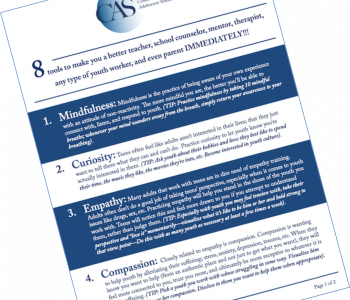

Catharine Hannay, MA
Catharine Hannay is the founder of MindfulTeachers.org and the author of Being You: A Girl’s Guide to Mindfulness, a workbook for teen girls on mindfulness, compassion, and self-acceptance.
How to Validate Teens (Even When You Don’t Agree)
Invalidation basically means expressing a lack of empathy toward someone’s feelings and experience of the world. Validation, then, conveys the message: I see you, I hear you, and I understand where you’re coming from and what you’re going through. Validation or invalidation aren’t always articulated verbally, but could be shown through a supportive or skeptical facial expression and tone of voice.
No matter how much you might struggle to understand a particular youth’s behavior or perspective, there’s almost always something you can find to validate, something that makes sense given their circumstances and view of the world.
In the words of the eminent psychologist Carl Rogers:
“As a psychotherapist, teacher, religious worker, guidance counselor, [or] clinical psychologist—it is the quality of the interpersonal encounter with the client which is the most significant element in determining effectiveness. […] If he perceives that I am trying to understand his meanings, this is helpful. It communicates the value I place on him as an individual. It gets across the fact that I perceive his feelings and meanings as being worth understanding.”
Rogers and Stevens, Person to Person: The Problem of Being Human
Finding Something Valid to Validate
It’s important to only validate what’s actually valid in a given situation. For example, “a coach may validate that it is upsetting to lose a game, while not validating the threat of quitting by saying that quitting makes sense. Or a doctor might validate the fear associated with getting an injection while not validating avoidance of the experience.” (What Works with Teens, p. 174)
In his book Tattoos on the Heart, Father Greg Boyle describes a boy named Lula, who’s struggling in school and seems to have a learning disability. One day, he comes into the office with a big smile, proudly showing off his report card. Father Boyle finds this rather confusing, since Lula’s grades are all F’s.
It would be cruel to tell him, “There’s nothing to be proud of here. You failed every class!” But it wouldn’t make sense to congratulate him for failing.
So how can he validate Lula in an honest and compassionate way?
As Father Boyle explains, “I am frantically perusing every inch of this report card to find something, anything for which to praise Lula. I find it. ‘Lula, nice goin’ mijo [my son] You didn’t miss a day.’ I high five him.” (Tattoos on the Heart: The Power of Boundless Compassion)
Despite his struggles to understand the lesson, Lula diligently shows up every day. That’s likely the one aspect of the situation he can control, and he takes his responsibility seriously. Father Boyle doesn’t give any false praise; Lula’s perfect attendance is a genuine achievement.
Validating Without Agreeing with Their Opinions
Imagine a student finds out he needs to give a class presentation and says, “Oh, man. I hate speeches!”
Now imagine his teacher reacting in one of the following ways:
A. “What? Speeches are awesome.”
B. “You talk all the time! You’re gonna love it.
C. “Shocker! Gabe has another complaint.”
D. Gabe, we enter the room silently, please.”
How might the situation play out differently if Gabe’s teacher responded with a question instead:
E. “What do you hate about speeches, Gabe?”
As Jennifer Gonzalez explains, in the first four scenarios, the teacher is “arguing with Gabe, dismissing his feelings, attacking him personally, or ignoring what he said altogether.” Option E, on the other hand, expresses curiosity rather than criticism, which sets the stage for understanding and validating Gabe’s experience with class presentations.
This type of response can work in a variety of contexts. For example, “if a student says, ‘I suck at math,’ you don’t say, ‘Yeah you do.’ Instead, you could just restate their words as a question: ‘You don’t think you’re good at math?’ This will prompt them to tell you more.”
(Jennifer Gonzalez, “The Magic of Validation” at cultofpedagogy.com)
Dr. Sam Himelstein describes what happened when one of his clients said he wasn’t interested in learning mindfulness meditation.
“When you hear meditation what comes up for you?” Dr. Himelstein asked. “What images come to mind?”
“F–in’ monks,” Martin said. “Hippies and shit. That’s why I don’t really think it’s for me.”
Dr. Himelstein didn’t agree with this description of mindfulness meditation, but he validated Martin’s perspective: “I could see why you might not be into it, thinking about it that way.”
After empathizing with Martin’s point of view, Dr. Himelstein explained his own opinion. “To me […] mindfulness is all about being real, being present and non-reactive. I see it less as something for monks and more for folks like us, living in the world dealing with anger, stress, and other emotions.”
Martin thought about this and said, “Oh okay. I didn’t really see it like that.”
After this conversation, Martin was willing to try mindfulness meditation. If Dr. Himelstein had dismissed or ignored his point of view, Martin likely would have continued to resist. Since his own perspective was validated, Martin was willing to listen to a different point of view.
(from Trauma-Informed Mindfulness with Teens: A Guide for Mental Health Professionals)
Validating Without Approving of Their Behavior
Julie Baron and Britt Rathbone give a couple of examples of helping teens change their behavior while validating the reasons behind the undesirable behavior.
The first example is a girl who keeps flirting with the boys in her youth group. Her minister wants her to tone it down, and he explains this in a way that makes her feel supported rather than insulted or invalidated.
In the girl’s own words, “He said it makes sense to want attention and know you are attractive to others, and he also told me how much he saw others value me in leadership situations—that my worth was way more than attention from boys.” (What Works with Teens, p. 160)
The second example is a seventeen-year-old named Keira, who was arrested because the police found drugs under the seat of her car. Keira snapped at the intake officer who suggested she could avoid a court appearance if she took a drug education class. Then she was so sarcastic to the judge that he sentenced her to ten days in jail for contempt of court.
Fortunately, at the juvenile detention center, Keira met with a social worker who calmly listened while she expressed her frustration. Since she had no idea that one of her friends had hidden drugs in her car, Keira resented the adults’ assumption she was guilty. In court, as the judge got more and more stern, Keira got more and more sarcastic, neither of them realizing how much they were setting each other off.
After validating her feelings at being falsely accused, the social worker offered to teach Keira how to express herself in a way that wouldn’t get her into trouble. They discussed what might happen the next time she appeared in court, and role-played different ways to respond. The next time Keira saw the judge, she was able to speak calmly while asserting her innocence. This time, she was released to her family rather than having to return to the detention center.
(What Works with Teens, p. 65-66)
“Interpreting an adolescent’s behavior as disrespectful naturally triggers dismissive, unempathetic, and unkind responses from adults. […]When becoming exasperated with teens’ disrespectful behavior [consider] whether they have the skills to behave the way we want. We sometimes mistakenly assume that the ability exists and they are choosing not to use it. […] If we respond only to ‘bad’ behaviors we may be missing the mark.
(Baron & Rathbone, What Works with Teens, p. p. 63; 66)
Conclusion
Unfortunately, invalidation of teens is all too common, particularly those from marginalized communities, those who are labeled ‘at-risk,’ or those who differ in any way from what’s considered the ‘norm.’
If you work with youth in any capacity, validation can be incredibly therapeutic for them and beneficial to your relationship with them. Validating youth doesn’t mean agreeing with anything and everything they say or do; it does mean that you make an effort to support them and understand their point of view.
There are many more posts here at the Center for Adolescent Studies on effectively communicating with and supporting teens, including:
3 Ways Compassion Can Help Youth Impacted by Trauma
4 ‘Must-Reads Books If You Care About Teens

